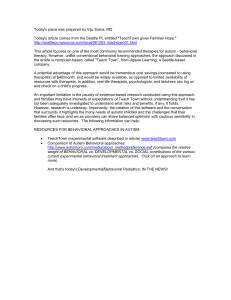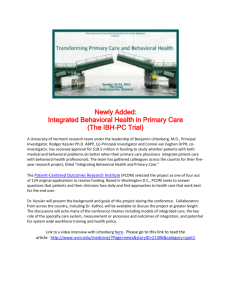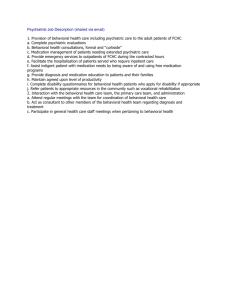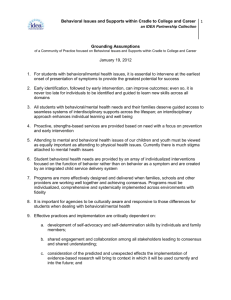Specific Aims Despite consistent and robust demonstrations by the
advertisement
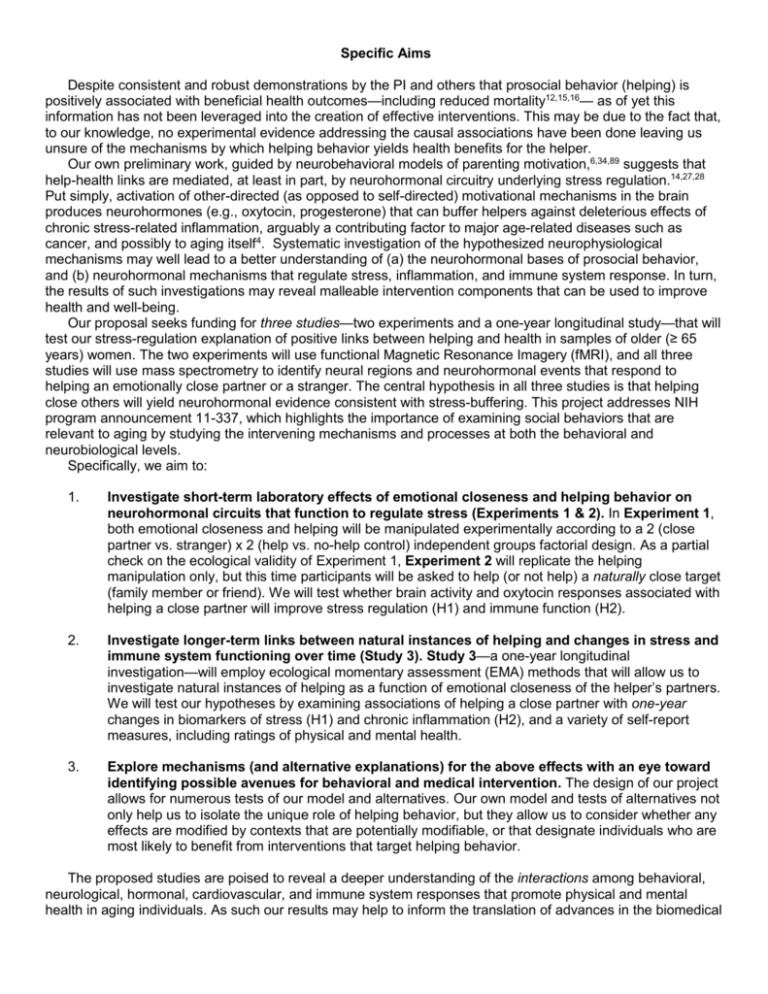
Specific Aims Despite consistent and robust demonstrations by the PI and others that prosocial behavior (helping) is positively associated with beneficial health outcomes—including reduced mortality12,15,16— as of yet this information has not been leveraged into the creation of effective interventions. This may be due to the fact that, to our knowledge, no experimental evidence addressing the causal associations have been done leaving us unsure of the mechanisms by which helping behavior yields health benefits for the helper. Our own preliminary work, guided by neurobehavioral models of parenting motivation,6,34,89 suggests that help-health links are mediated, at least in part, by neurohormonal circuitry underlying stress regulation.14,27,28 Put simply, activation of other-directed (as opposed to self-directed) motivational mechanisms in the brain produces neurohormones (e.g., oxytocin, progesterone) that can buffer helpers against deleterious effects of chronic stress-related inflammation, arguably a contributing factor to major age-related diseases such as cancer, and possibly to aging itself4. Systematic investigation of the hypothesized neurophysiological mechanisms may well lead to a better understanding of (a) the neurohormonal bases of prosocial behavior, and (b) neurohormonal mechanisms that regulate stress, inflammation, and immune system response. In turn, the results of such investigations may reveal malleable intervention components that can be used to improve health and well-being. Our proposal seeks funding for three studies—two experiments and a one-year longitudinal study—that will test our stress-regulation explanation of positive links between helping and health in samples of older (≥ 65 years) women. The two experiments will use functional Magnetic Resonance Imagery (fMRI), and all three studies will use mass spectrometry to identify neural regions and neurohormonal events that respond to helping an emotionally close partner or a stranger. The central hypothesis in all three studies is that helping close others will yield neurohormonal evidence consistent with stress-buffering. This project addresses NIH program announcement 11-337, which highlights the importance of examining social behaviors that are relevant to aging by studying the intervening mechanisms and processes at both the behavioral and neurobiological levels. Specifically, we aim to: 1. Investigate short-term laboratory effects of emotional closeness and helping behavior on neurohormonal circuits that function to regulate stress (Experiments 1 & 2). In Experiment 1, both emotional closeness and helping will be manipulated experimentally according to a 2 (close partner vs. stranger) x 2 (help vs. no-help control) independent groups factorial design. As a partial check on the ecological validity of Experiment 1, Experiment 2 will replicate the helping manipulation only, but this time participants will be asked to help (or not help) a naturally close target (family member or friend). We will test whether brain activity and oxytocin responses associated with helping a close partner will improve stress regulation (H1) and immune function (H2). 2. Investigate longer-term links between natural instances of helping and changes in stress and immune system functioning over time (Study 3). Study 3—a one-year longitudinal investigation—will employ ecological momentary assessment (EMA) methods that will allow us to investigate natural instances of helping as a function of emotional closeness of the helper’s partners. We will test our hypotheses by examining associations of helping a close partner with one-year changes in biomarkers of stress (H1) and chronic inflammation (H2), and a variety of self-report measures, including ratings of physical and mental health. 3. Explore mechanisms (and alternative explanations) for the above effects with an eye toward identifying possible avenues for behavioral and medical intervention. The design of our project allows for numerous tests of our model and alternatives. Our own model and tests of alternatives not only help us to isolate the unique role of helping behavior, but they allow us to consider whether any effects are modified by contexts that are potentially modifiable, or that designate individuals who are most likely to benefit from interventions that target helping behavior. The proposed studies are poised to reveal a deeper understanding of the interactions among behavioral, neurological, hormonal, cardiovascular, and immune system responses that promote physical and mental health in aging individuals. As such our results may help to inform the translation of advances in the biomedical and behavioral sciences to the clinic for the purpose of developing non-invasive behavioral health and mental health interventions.



